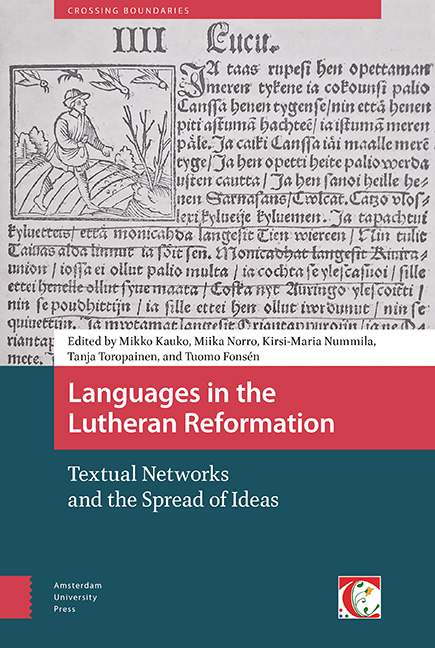Book contents
- Frontmatter
- Contents
- List of Figures and Tables
- Preface
- Introduction
- Part I The Reception of Luther's Ideas and their Influence for the Development of Written Languages
- Part II Effects of Bible Translations on the Evolution of Written Language
- Part III Reuse of (Catholic) Texts after the Reformation
- Part IV Language Contacts and Loanwords
- Index
6 - The Infant Jesus and his Mother in Late Mediaeval and Early: Modern Scandinavian Book Culture
Published online by Cambridge University Press: 21 November 2020
- Frontmatter
- Contents
- List of Figures and Tables
- Preface
- Introduction
- Part I The Reception of Luther's Ideas and their Influence for the Development of Written Languages
- Part II Effects of Bible Translations on the Evolution of Written Language
- Part III Reuse of (Catholic) Texts after the Reformation
- Part IV Language Contacts and Loanwords
- Index
Summary
Abstract
The essay looks at apocryphal stories about the child Jesus and his mother Mary in late mediaeval and early modern Nordic literature. This material has its origins in the first centuries of Christianity and became very popular in the Middle Ages as Marian worship gained ground. The stories were known in the Nordic countries, as elsewhere in Europe, in mediaeval times and they seem to have retained their popularity in the centuries following the Reformation. The essay focuses on the use of the texts and how they were spread, especially to the areas of Norway and Iceland. Their dissemination provides an excellent proof of how old popular themes could survive reforms if adapted to a new cultural context and changed expectations.
Keywords: Apocryphal New Testament, Jesu Barndoms Bog, Norwegian, Icelandic, Virgin Mary
Introduction
As is well known to those familiar with the Bible, the Gospels offer little information about Jesus's childhood. The story of the Nativity is related in Matthew and Luke; in Matthew we also learn about the Flight to Egypt; while Luke includes two scenes that take place at the Temple in Jerusalem: that of Simeon blessing the infant Jesus; and the discussion the twelve-year-old Jesus has with the elders. Nothing further is written about Jesus's life until he approaches John the Baptist at Jordan and his brief career as a religious leader begins. There is similarly very little information about Joseph and Mary in the Gospels, and it seems that stories began to circulate early on that were aimed at putting this right by offering some background history of the Holy Family. In the course of time, stories of this kind spread far and wide and proved to have enduring popular appeal, irrespective of any doctrinal issues that may have troubled theologians and church leaders. Doctrinal concerns certainly shaped the reception of these texts, but the continuing demand for stories about the Holy Family meant that the core narratives were transmitted from the Eastern Church to the West and later adopted – and adapted – by Lutherans after the Reformation. In this essay we will describe the introduction of this material into Old Norse literature in mediaeval times before discussing its reintroduction as a chapbook text in Denmark, Norway, and Iceland and the different aspects of its dissemination in these countries.
- Type
- Chapter
- Information
- Languages in the Lutheran ReformationTextual Networks and the Spread of Ideas, pp. 151 - 172Publisher: Amsterdam University PressPrint publication year: 2019

